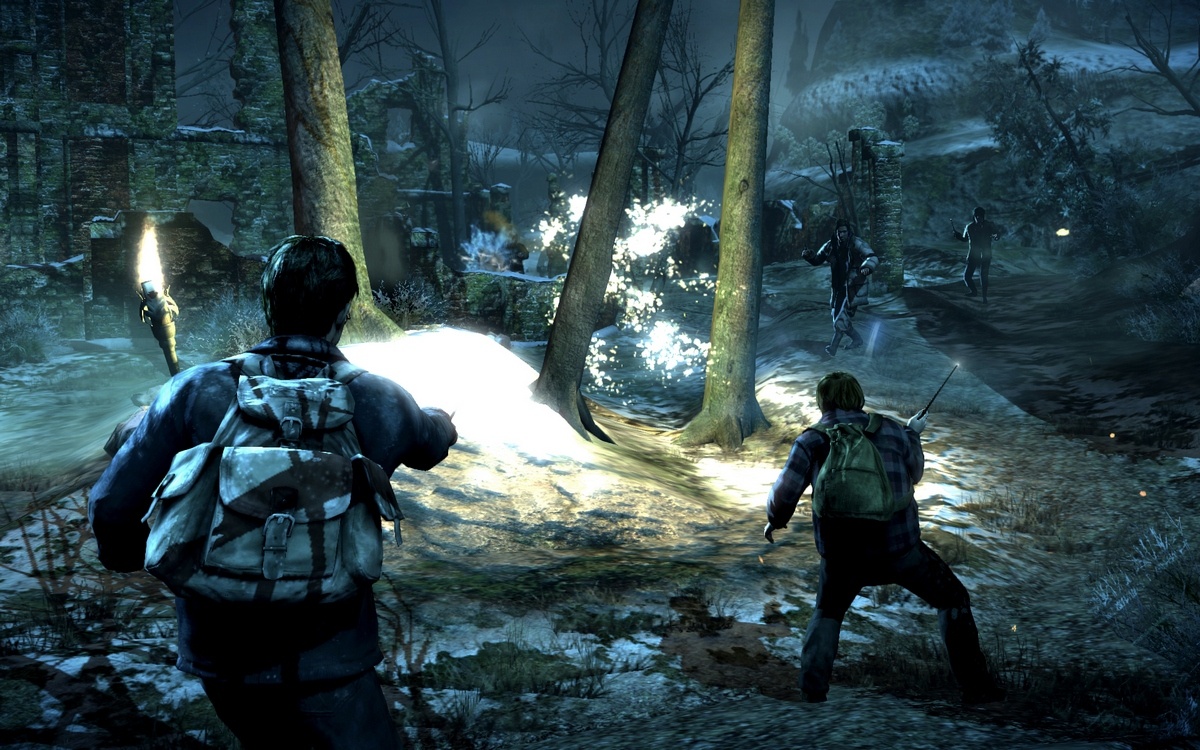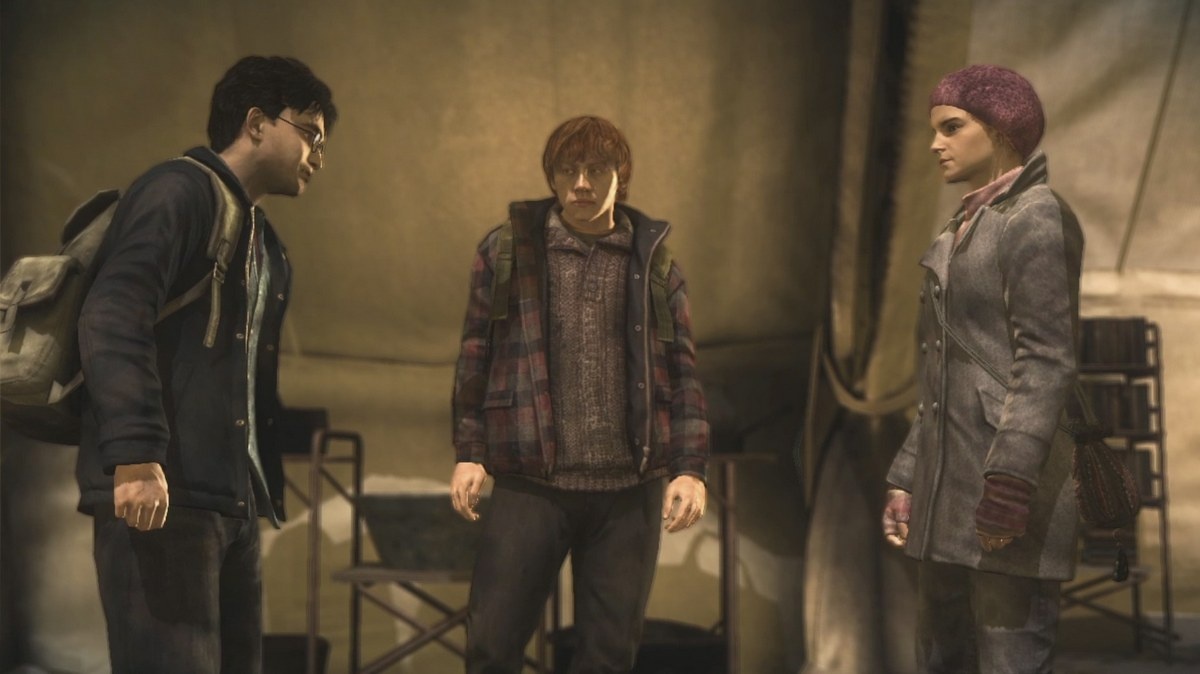Harry Potter and the Deathly Hallows Video Game Review
Harry Potter and the Deathly Hallows Part 1 Review
While the third-person shooter aspect of Harry's latest adventure can be fun, the game'south story elements fail to live up to those of its literary namesake.
The near disappointing thing about Harry Potter and the Deathly Hallows Part 1 is that information technology fails to capture the essence of the story information technology's trying to tell. While the revamped third-person shooter gameplay stays engaging throughout nearly of the entrada, the context that it's framed around is cardboard. There is no attempt to tie the onscreen action to the motivation of the hero performing it; nor is at that place a coherent and engaging narrative to complement the gameplay and inject some sense of purpose. Crude graphic symbol models, bad voice acting, a fragmented storyline, and a variety of bugs transform the richly detailed and minutely imagined world of Harry Potter into an feel as colorless as 1 of Professor Snape's lessons.
The terminal journeying facing Harry Potter is not an easy one. Darkness, loss, and death now fill the space one time inhabited by classes, Quidditch, and dorm-room chitchat. At that place are no more than schoolyard adventures, traipses through the forest, or twilight romances past the lake. Instead, Harry, Ron, and Hermione must venture past Hogwarts into the common cold, wet English countryside, tracking downwards and destroying the remaining parts of Voldemort's soul. This is the picture painted so clearly and heartbreakingly past J.K. Rowling'southward last Harry Potter book then unceremoniously represented here. Non only does the game'south story take liberties with the canon (when did Harry, Ron, and Hermione ever venture inside an abandoned factory?), only those elements of the story that are reflected accurately are portrayed through short, fragmented cutscenes that look dire and are completely unconvincing, making the story confusing and unclear for those unfamiliar with the books.
Important plot points are glossed over in favour of combat, and the game does very footling to explain what drives these characters to exercise what they do. What's more, cutscenes take the emotional range of a teaspoon, to use Hermione'southward own words. What is supposed to be one of the most touching moments of the terminal book is reduced to a cutscene and then cursory and so badly acted yous can just laugh. The character models too exit a lot to the imagination and are plagued past awkward movements, a perpetual stiffness of the pilus and clothes, and out-of-sync talking, non to mention extremely express dialogue--Ron is particularly fond of shouting "Nosotros can't do this!" during every single gainsay sequence at regular intervals, which is annoying at starting time and completely soul-destroying past the time you finish the game.
Looking past the problematic storytelling elements, the gameplay itself is fun for the most part, especially if yous can wait past the fact that you won't be doing much else. The third-person shooter makeover sees you controlling Harry from an over-the-shoulder perspective, with a targeting system and cover mechanic also at his disposal. Most of the combat is free-flowing and rapid, nevertheless some camera issues stop it from being a completely rewarding experience. In some parts of the game, the camera becomes uncooperative and results in extreme shut-ups, commonly when you're moving in and out of cover or navigating within small spaces. This is something that almost ever ends in disaster--it's impossible to determine the management of killing curses when the whole screen is filled with the lesser left-hand corner of Harry's bluish jumper. What Harry "shoots" are various spells; each spell's intensity increases over fourth dimension, with Harry levelling up throughout the entrada and eventually unlocking 10 spells overall, including Expelliarmus, Expecto Patronum, and Petrificus Totalus. The spells are assigned to a spell wheel that you can either wheel through using the right bumper or bring upward every bit a radial bill of fare. The targeting system also works smoothly and is responsive throughout the whole game, activated by pressing the left trigger to lock on with the reticle, and the right trigger to shoot. The fact that the display features no health or magic bar (with health obtained from various potions dropped by defeated enemies) also helps to brand the experience smoother and more than immersive, at least during those parts when the camera isn't acting up.

Well-nigh of the game is composed of Harry, Ron, and Hermione moving from identify to identify, fighting hordes of Expiry Eaters (Voldemort's cronies), Inferi (dead people), and Snatchers (rudimentary bad dudes). Combat takes upwardly the entirety of the gameplay, leaving no room for the more than imaginative exploration and puzzle-solving that featured strongly in earlier Harry Potter games. To recoup for this, you're required to take part in four sets of mini challenges at certain points in the game--each set is made up of three brusk challenges that accept no begetting on the story and involve Harry defeating a sure number of enemies or surviving an oncoming attack. These challenges are pointless and apace become tedious, and in that location is no motivation to complete them other than that you cannot continue in the single-player campaign without doing then. Calculation to this badgerer are occasional gameplay bugs plant throughout the whole entrada, the more than interesting of which include invisible walls and odd AI behaviour (hey, death eater, why do you proceed angle over that desk at xxx-second intervals?). At that place is as well very fiddling diversity in enemy non-player characters--there announced to be only 3 types of Death Eaters and three types of Snatchers, with absolutely no deviation between the character models, which means you're often fighting an regular army of clones. Again, this doesn't aid with the immersion attribute.
While shooting the identify upward similar you're Yosemite Sam can be satisfying, it doesn't make for a very convincing Harry Potter game. Harry is a tortured, confused, and deeply anti-fierce adolescent. It's true that these traits don't exactly make him the perfect video game character, but the game inappreciably fifty-fifty tries to stand for the weight behind the choices he makes or the gravity of what he is facing. There are merely two instances in the whole campaign when a certain kind of sensibility shines through. The showtime is during the outset-person manner that's triggered when Harry puts on his invisibility cloak (accessible at any time by pressing the Y button). Someone put a lot of thought into this element--not only does the camera really work smoothly in this part, but while Harry is wearing the cloak (encouraged in situations where it's prudent to be stealthy rather than go in guns blazing for fear of being overpowered), you can hear his deadening, frightened breath in your ear, every bit if you were nether the cloak with him. Information technology'southward a wonderful touch. The second instance occurs during a Tim Burtonesque sequence that tells the story of the Deathly Hallows through shadow puppetry. While this is taken directly from the Deathly Hallows motion-picture show, it is reproduced hither with a softness and grace that is both visually stunning and emotionally arresting.
Outside of the primary campaign there'southward a Challenge mode and a Kinect mode that uses Microsoft'due south new move-control system. Claiming way includes 20 tasks based around survival, stealth, and time attack goals where you lot must survive attacks for a sure amount of time, or defeat all enemies using simply ane spell, so on, in easy, medium, and hard difficulties. Although there are online and offline modes, the challenges are the same, with the only deviation beingness that yous are scored in online leaderboards after y'all complete a task if you choose the online mode before starting.

Kinect mode includes 22 challenges: 12 unmarried-player and 10 two-player offline co-op challenges. The theme is the same equally in the other challenges: yous must survive attacks for a certain corporeality of time, or defeat all enemies using only one spell, and so on. While the challenges start out being fun to play, it's not long earlier your right hand feels every bit heavy and limp as a expressionless fish. The gameplay in these challenges consists of an on-rails shooter-blazon scenario: you have a 3rd-person view of Harry as he moves of his own accord on the screen, with his wand arm mimicing your right arm as you perform the movements that pop up. These are fairly bones: shooting requires a simple flicking of the right arm towards the onscreen target or swiping your right arm across your chest as if yous were performing a backhand in tennis; charging spells crave you to concur your right arm to a higher place your shoulder for a second before flicking information technology forwards; protective spells require you to raise both arms in a stopping motion; and finally, throwing potions requires a uncomplicated brawl-throw at the screen with the left arm (at that place doesn't seem to exist any option for reversing these controls if yous are left-handed). The challenges aren't very long, but don't expect to be able play more than iii or four in a row. Dedicated Kinect leaderboards can be accessed through Xbox Live, and there are achievements linked to completing these challenges. Yous're only able to cast five unlike spells while using your paw as a wand in these challenges, and yous never become more than than two spells per claiming. The single-player campaign spell upgrades are also absent.
Harry Potter and the Deathly Hallows Function 1 is an easy game to forget. Shooting bad guys with little context is enjoyable for a while, but shortly enough it becomes impossible to ignore the same problematic aspects present in the last few Harry Potter games--occasionally bad camera, bugs, and a distinct lack of narrative cohesion--resulting in a barely in that location take a chance that does petty justice to the source material. The activity is functional, merely not particularly satisfying, and the elements that stand for the core entreatment--the story, characters and universe--fail to live upwards to the Harry Potter name.
Source: https://www.gamespot.com/reviews/harry-potter-and-the-deathly-hallows-part-1-review/1900-6284282/
0 Response to "Harry Potter and the Deathly Hallows Video Game Review"
Post a Comment